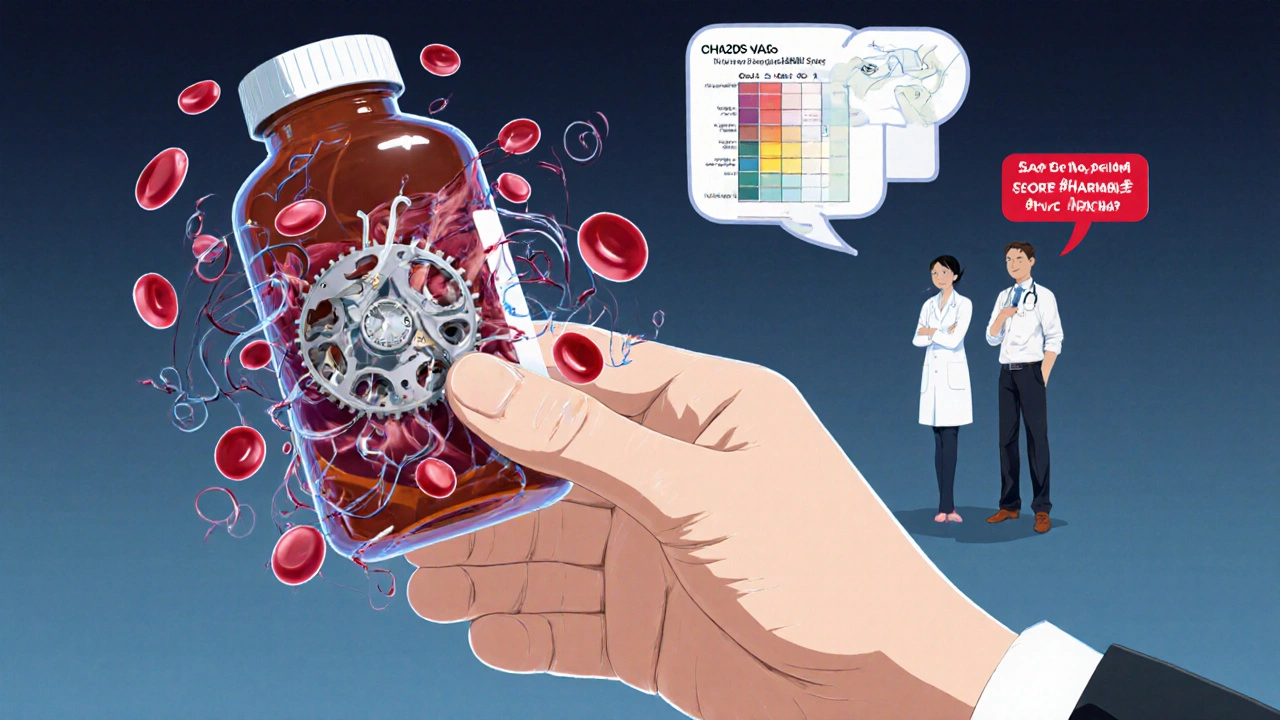Bridging Therapy Decision Tool
Find out if you need bridging therapy
This tool helps determine if bridging therapy is recommended based on the latest medical guidelines.
Enter your information above to see if bridging therapy is recommended for your situation.
Switching between blood thinners isn’t something you do on a whim. It’s a high-stakes decision that can mean the difference between a clot forming in your heart or lung-and serious, even deadly, bleeding. For many people on long-term anticoagulation, this transition happens when they need surgery, a dental procedure, or when their doctor decides it’s time to switch from warfarin to a newer drug. But here’s the thing: bridging therapy isn’t always the answer. In fact, for most people today, it’s not needed at all.
What Is Bridging Therapy, Really?
Bridging therapy means using a fast-acting injectable blood thinner-like low molecular weight heparin (LMWH) or unfractionated heparin-to cover the gap when you stop your regular blood thinner, usually warfarin. The idea is simple: stop the slow-acting drug, inject something that works right away, and then stop the injection before your procedure to reduce bleeding risk. After the procedure, you restart your original blood thinner. But this isn’t just about timing. It’s about risk. The goal isn’t to keep you perfectly protected at all times-it’s to avoid clots without causing dangerous bleeding. And here’s where things changed. In 2015, the BRIDGE trial shook up the whole field. Researchers looked at over 1,800 patients with atrial fibrillation who needed temporary interruption of warfarin for surgery. Half got bridging with LMWH. The other half didn’t. The results? Bridging didn’t lower the risk of stroke or clots. But it doubled the chance of major bleeding-from 1% to 2.3%. That’s not a small trade-off. It’s a clear signal: for most people, the risks of bridging outweigh the benefits.When Is Bridging Actually Necessary?
You might be surprised to learn that only a small group of patients still need bridging. The guidelines now say: only if you’re at very high risk for clots. That means:- Having a mechanical heart valve in the mitral position
- Having had a blood clot in your leg or lung within the last 3 months
- Having atrial fibrillation with a CHA₂DS₂-VASc score of 5 or higher (and other high-risk factors)
Why DOACs Changed Everything
If you’re on warfarin, you’re in the minority. In 2023, about 75% of new prescriptions for blood thinners were for DOACs-drugs like apixaban (Eliquis), rivaroxaban (Xarelto), dabigatran (Pradaxa), and edoxaban (Savaysa). And here’s the big advantage: you don’t need bridging with these. DOACs work fast. They peak in your blood within 2-4 hours. They leave your system just as quickly-half of it is gone in 5 to 17 hours, depending on your kidney function. That means you can stop them 24 to 48 hours before a procedure, depending on the type and your kidney health, and start them again within 24 hours after. No injections. No daily shots. No need to monitor INR levels. Switching from a DOAC to warfarin? That’s a different story. You don’t bridge here either. Instead, you start warfarin at the same time you stop the DOAC. Your doctor will monitor your INR over the next few days and adjust the warfarin dose based on the results. You might even get a small dose of LMWH for a day or two if your INR is slow to rise-but that’s not bridging. It’s just a temporary safety net.
How Bridging Works with Warfarin (If You Really Need It)
If your doctor says you’re in the small group that still needs bridging, here’s what the timeline looks like:- Stop warfarin 5 to 6 days before your procedure. That’s because it takes that long for your INR to drop below 1.5.
- Start therapeutic-dose LMWH (like enoxaparin) 3 days before the procedure. This is usually 1 mg per kg of body weight, given twice a day.
- Stop the LMWH 24 hours before surgery. If you’re on a lower, prophylactic dose, stop it 12 hours before.
- After the procedure, restart LMWH 24 to 48 hours later-only if there’s no active bleeding.
- Restart warfarin the same day you restart LMWH, but increase the dose by 15-20% from your usual amount. Your INR will be checked in 3 to 4 days.
The Hidden Risks of Bridging
Bridging isn’t just risky because of bleeding. It’s risky because it’s complicated.- LMWH requires daily injections. Many patients miss doses-studies show 15-20% don’t stick to the schedule.
- It’s expensive. A 7-day course of LMWH can cost $300 to $500 in the U.S., and even more if you need hospital administration.
- Timing is everything. If your procedure gets delayed, your INR might drop too low, or your LMWH might still be in your system. That means rescheduling or adjusting the plan.
- Some people develop heparin-induced thrombocytopenia (HIT), a rare but life-threatening condition where your body forms clots in response to heparin.

What to Do If You’re on Blood Thinners
If you’re on warfarin or a DOAC and you know you’ll need a procedure soon, here’s your action plan:- Don’t stop your blood thinner on your own. Ever.
- Ask your doctor: “Am I in a high-risk group for clots? Do I really need bridging?”
- If you’re on a DOAC, ask: “Can I just pause it for a day or two and restart after?” The answer is likely yes.
- If you’re on warfarin, ask: “Is my CHA₂DS₂-VASc score above 5? Have I had a clot in the last 3 months?” If no, bridging is probably unnecessary.
- Get a written plan. Include exact dates for stopping and restarting each medication.
- Make sure your surgeon and pharmacist are on the same page. Don’t assume they know your regimen.
The Bottom Line
Bridging therapy isn’t a one-size-fits-all solution. It’s a tool for a very narrow set of patients-and even then, it’s used less often than it used to be. For the vast majority of people on blood thinners, especially those on DOACs, the safest path is simple: pause the drug, do the procedure, restart the drug. No shots. No extra risk. No confusion. The medical community has learned the hard way: more intervention doesn’t always mean better outcomes. Sometimes, doing less-carefully, deliberately, and with evidence-is what keeps you safest.If you’re scheduled for a procedure and you’re unsure about your blood thinner plan, ask for a medication review with your pharmacist. They’re trained to spot these risks. And if your doctor recommends bridging without explaining why-ask for the evidence. You deserve to know why you’re being asked to take on extra risk.
Do I need bridging therapy if I’m on Eliquis or Xarelto?
No. Direct oral anticoagulants (DOACs) like Eliquis and Xarelto leave your body quickly-within 12 to 48 hours, depending on your kidney function. You can stop them 24 to 48 hours before a procedure and restart them within 24 hours after, with no need for injections or bridging. This is now standard practice for most patients.
Can I skip bridging if I have atrial fibrillation?
For most people with atrial fibrillation, yes. Bridging is only recommended if you have a CHA₂DS₂-VASc score of 5 or higher AND you have additional risk factors like a recent clot. For the majority, the risk of bleeding from bridging outweighs the small benefit. The 2020 American Heart Association guidelines now strongly advise against routine bridging for atrial fibrillation.
What if I’m on warfarin and need a dental procedure?
For most dental work-even extractions-you don’t need to stop warfarin at all. The risk of bleeding is low, and stopping increases clot risk. If your dentist is concerned, they can use local measures like sutures or hemostatic gels. Bridging is never needed for routine dental procedures. Always check with your doctor first, but don’t assume you need to stop your medication.
How long should I wait to restart my blood thinner after surgery?
It depends on the surgery and your bleeding risk. For minor procedures, you can restart within 24 hours. For major surgery or spinal procedures, you may wait 48 to 72 hours. If you were on bridging with LMWH, you restart warfarin the same day you restart the heparin. Your doctor will check your INR in 3 to 4 days and adjust the dose. Never restart without medical guidance.
Is bridging therapy still used in hospitals today?
Yes-but only in specific cases. Most hospitals now follow updated guidelines that limit bridging to patients with mechanical mitral valves or recent clots. Many have stopped offering it entirely for atrial fibrillation patients. The trend is clear: fewer patients are getting bridged, and those who are have clear, documented high-risk criteria.

